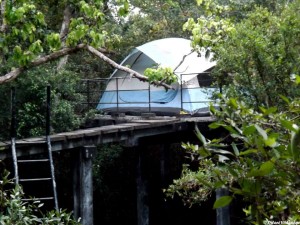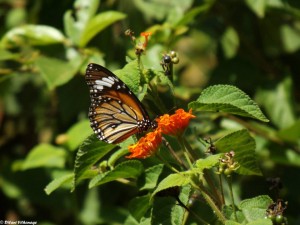I had my first camping experience last weekend when the third year Environmental Science students took part in a field workshop at the Wasgamuwa National Park (WNP) under the guidance of Dr. Mayuri Wijesinghe.
We left Colombo early Friday morning and reached the WNP Visitor Center by late afternoon. Mr. Samaranayake, the Park Warden of WNP gave us a brief history of the park. Wasgamuwa National Park, which is situated in Polonnaruwa and Matale districts, was established in 1984 as a measure to provide refuge for the animals that had been displaced during the Mahaweli Development Project and to protect the watershed. It is the 4th largest National Park in Sri Lanka and its landscape comprises of monsoon and riverine forests interspersed with grasslands and scrublands.
He also spoke to us on the problems faced by the local communities bordering the Park, the biggest problem being the human-elephant conflict. He said that several complaints had been made by the local communities regarding damage done to crops and property. Someone who doesn’t know the facts may be quick to pin the blame on the elephants. Truth is, there’s more to this issue than what meets the eye.
There are long spells of dry weather in and around Wasgamuwa. The lands and water bodies get dried up quickly leaving the animals hungry and thirsty. These animals move around in search of food and water. They sense the smell of crops from nearby plantations and as a result they encroach the villages. Farmers also fail to realize that each time they set fire to their cultivations they make the forest cover smaller, thereby reducing the elephant’s habitat.
Electric fences have been put up in order to prevent these animals from encroaching the villages. But these fences aren’t safe. Researchers, together with the local communities, are currently testing the use of bee hives as live fences in some National Parks in the country. If proven effective, the Park Warden said he too would implement these live fences at Wasgamuwa.
After the much insightful conversation with the Park Warden it was time to go to the Madapitiya Camping Site where we set up our tents.

There was no tap water at the camp site which meant we had to go down to the stream each time we needed water. We got used to it in no time. There was also no electricity so we made use of lanterns and torches. (Note: A head torch comes in handy in such situations – we felt its worth when we had trouble figuring out where best to keep our lanterns and torches when bathing in the stream!).
In the evening we set up a few mammal traps and laid them in different locations near the camp site. We kept charred coconut as bait. The following day we had a look at the traps and found that a squirrel and a rat had been caught. The animals were weighed and observed to establish their identity and then they were released back to their microhabitats. We also laid a few dung beetle traps using elephant dung in order to collect data on the diversity among dung beetles at WNP. We then set off to Dambarawawewa and Wilmitiyawewa to carry out water quality sampling.
We sighted a number different species of birds and butterflies as well as herds of elephants, spotted deer and wild buffaloes. Although the name Wasgamuwa has been derived from “Walas Gamuwa” (forest of the bear) we didn’t see a single sloth bear. However we did hear its call one morning and saw fresh foot prints on the trail leading to our camp site.


All in all it was a well spent weekend out in the wild . People usually go camping when they’re on holiday. I got the chance to go camping because my course work took me there! As Environmental Science students we have to take it upon ourselves to manage the natural resources of this country. It is also up to us to disseminate our knowledge to the local communities so that man and nature can live in harmony.


